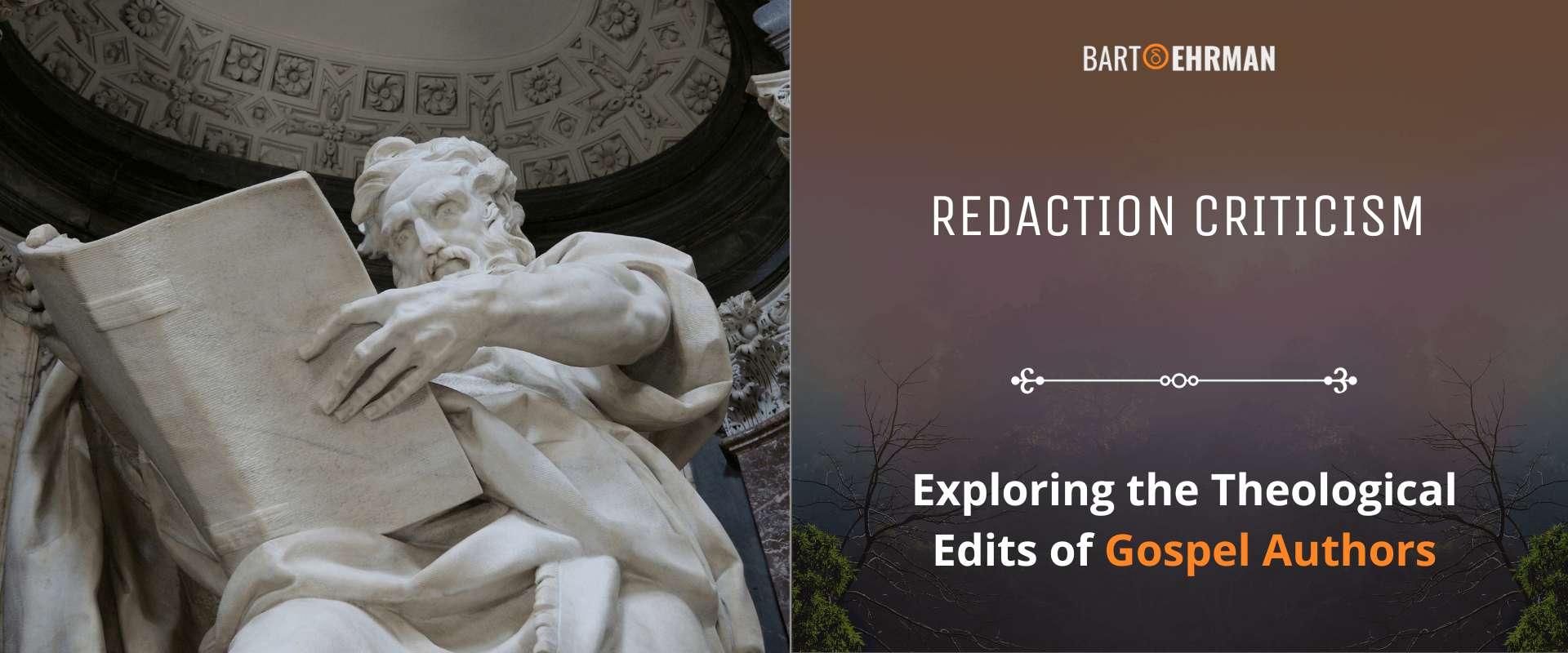Redaction Criticism: Exploring the Theological Edits of Gospel Authors

Written by Joshua Schachterle, Ph.D
Author | Professor | Scholar
Author | Professor | BE Contributor
Verified! See our editorial guidelines
Verified! See our guidelines
Date written: October 16th, 2023
Disclaimer: The views and opinions expressed in this article belong to the author and do not necessarily match my own. - Dr. Bart D. Ehrman
For those interested in biblical interpretation, understanding redaction criticism is a must. But what is redaction criticism? In this article, I’ll start with a redaction criticism definition and overview and how it emerged from other methods called source criticism and form criticism. I’ll then look specifically at how redaction criticism has been used by scholars to study the Gospels.

What are Source Criticism and Form Criticism?
When scholars started studying the Bible critically in the 19th and 20th centuries, they used several methods. Source criticism tried to establish the sources for biblical texts. A subset of source criticism was called form criticism. Form criticism studies the Bible by breaking texts down into brief units known as pericopes. They then categorize these pericopes by genre. These can include poetry, prose, hymns, letters, and a whole host of others.
Having distinguished these different genres within a text, form critics use the pericopes to theorize about the origins of each distinct pericope, including the date, authorship, and historical context. In this way, they hope to trace a text’s composition back to its original sources.
As an example, Paul’s letters contain material that can likely be traced back to a pre-Pauline Christianity. In Philippians 2:6-11, for example, Paul tells his readers they should have the same mind as Christ,
who, though he existed in the form of God,
did not regard equality with God
as something to be grasped,
but emptied himself,
taking the form of a slave,
assuming human likeness.
And being found in appearance as a human,
he humbled himself
and became obedient to the point of death—
even death on a cross.
Therefore God exalted him even more highly
and gave him the name
that is above every other name,
so that at the name given to Jesus
every knee should bend,
in heaven and on earth and under the earth,
and every tongue should confess
that Jesus Christ is Lord,
to the glory of God the Father.
Gregory Fewster, like most scholars, believes that these verses come not from Paul himself but from an earlier Christian hymn that Paul (and possibly his readers in Philippi) was taught. If so, it shows us that even before Paul’s exalted view of Jesus, other Christians also believed that Jesus was divine and preexistent. So where does redaction criticism come in?
In short, redaction criticism grew out of form criticism.
What is Redaction Criticism?
The word “redaction” simply means editing, although these days it is almost exclusively applied to the academic study of the Bible.
What is the difference between redaction criticism and form criticism? Form criticism assumes that the texts of the Bible were combinations of different sources. Redaction criticism takes that idea and studies how the author or compiler of a text put together those sources in order to make theological points. In other words, the way in which the pieces are put together, as well as what is added to or left out of an original source, can reveal the author’s intention.
The Gospels are excellent texts to study in this way since they often present different versions of many of the same stories and sayings. Redaction critics use the differences to determine what specific point the authors were trying to convey. Let’s look at redaction criticism of the Synoptic Gospels.
Redaction Criticism in Matthew
Over and over in the Gospel of Matthew, the author refers to proof-texts from the Hebrew Bible. For example, in referring to Jesus’ miraculous conception, we see this verse:
All this took place to fulfill what had been spoken by the Lord through the prophet:
“Look, the virgin shall become pregnant and give birth to a son and they shall name him Emmanuel…”
Why did the author of Matthew feel the need to paste together so many stories of Jesus with Hebrew Bible proof-texts? Well, he makes it pretty obvious: he believes Jesus is clearly the Messiah precisely because Jesus fulfills so many ancient prophecies. By contrast, Luke’s birth narrative doesn’t refer to prophecy at all, indicating that his concerns lay elsewhere.
Redaction Criticism in Luke
In another article, I noted that Matthew, Mark, and Luke share a lot of material. For redaction critics, though, the differences between them are most revealing. We find one important example of this in the Beatitudes in Matthew and Luke.
In Matthew 5:3, Jesus says “Blessed are the poor in spirit for theirs is the kingdom of heaven.” Luke 6:20 has Jesus say something similar: “Blessed are you who are poor, for yours is the kingdom of God.” What could account for the difference here, assuming they were using the same source (known by scholars as Q)?
It would appear that for Luke, real, literal poverty is the major concern. That tracks well with the rest of Luke, which is concerned with uplifting the poor and downtrodden. Look, for example, at these verses from Mary’s song of praise in Luke 1:
[God] has shown strength with his arm;
he has scattered the proud in the imagination of their hearts.
He has brought down the powerful from their thrones
and lifted up the lowly;
he has filled the hungry with good things
and sent the rich away empty.
Luke’s redaction of Q, then, reflects his focus on helping the poor.
Matthew and Luke’s Redaction of Mark: Jesus’ Rejection at Nazareth
Scholars know that since Mark was our earliest written Gospel, Matthew and Luke both used it as a source for their Gospels. As a final example, let’s look at how they took a story from Mark and edited it differently.
In Mark 6:2-3, Jesus goes back to Nazareth, his hometown, and preaches in the synagogue. His preaching astounds the locals who wonder how this local boy has become such a religious authority.
They said, “Where did this man get all this? What is this wisdom that has been given to him? What deeds of power are being done by his hands! Is not this the carpenter, the son of Mary and brother of James and Joses and Judas and Simon, and are not his sisters here with us?” And they took offense at him.
Jesus is rejected in his hometown in all the Synoptic Gospels. The key differences, though, are how Jesus is described or identified by the locals. In Mark he is a carpenter and the son of Mary, with no father named.
Checking in with Matthew, the description changes a bit.
“Isn’t this the carpenter’s son? Isn’t his mother’s name Mary, and aren’t his brothers James, Joseph, Simon and Judas? Aren’t all his sisters with us? Where then did this man get all these things?” And they took offense at him.
Now Jesus is not a carpenter but “the carpenter’s son.” What might this tell us about Matthew’s purpose?
Mark begins with Jesus as an adult being baptized and adopted as God’s son at his baptism. For Matthew, though, Jesus was the son of God at his conception. This means that for Mark, Jesus was likely a regular human being until being adopted by God. He could, therefore, have a normal life as a carpenter before his baptism.
But for Matthew, Jesus could have been raised by a carpenter but, as a divine person, would never have stooped so low as to be a carpenter.
What does Luke do with this story? His version of the locals’ description in Luke 4:22 is slightly different from both Mark’s and Matthew’s versions.
All spoke well of him and were amazed at the gracious words that came from his mouth. They said, “Is this not Joseph’s son?”
Now Jesus is the son of Joseph. What is the significance of this? In ancient Palestine, sons were usually described as sons of their fathers. Luke, having his own version of Jesus’ divine origins, denies any connection with a low-status profession like carpentry and makes him the son of his father rather than the son of Mary. All of this raises Jesus’ status.

Conclusion: What Can Redaction Criticism Teach Us About the Gospels?
What is redaction criticism? Redaction criticism is a method of biblical interpretation in which we examine how an author (or compiler) of a text arranged and edited his sources in order to convey or emphasize his theological points.
Scholars know, for example, some of the sources used to create the Synoptic Gospels. By analyzing how those sources are put together and what is both added and subtracted from them, redaction critics attempt to discover the intention of the authors.
What can we Learn from redaction criticism? By seeing how Matthew and Luke differed in their use of Q as a source, for example, we can see how they emphasize different theological points.
For Matthew, Jesus is the Davidic Messiah fulfilling prophecies from the Hebrew Bible through his words and deeds. For Luke, on the other hand, Jesus is a teacher of wisdom who has come to save the poor and downtrodden.
Redaction criticism gives scholars information about the likely intentions of the Gospel authors.

